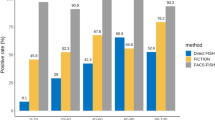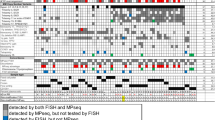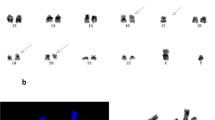Abstract
Conventional cytogenetics (CC) at clinical diagnosis shows a normal karyotype in 40–60% of de novo myelodysplastic syndromes (MDSs). Fluorescence in situ hybridization (FISH) might detect occult aberrations in these patients. Therefore, we have used FISH to check 57 MDS patients who were karyo-typically normal on CC. At clinical diagnosis, FISH revealed a clonal abnormality in 18–28% interphase cells from nine patients, five of whom also presented the same defect on metaphase FISH. In five out of nine patients, the occult defect effected a change in the international prognostic scoring system (IPSS). An abnormal FISH pattern was significantly correlated with marrow blast cell percentage (P<10−3) and IPSS (P<10−3). Patients with an occult abnormality showed an overall survival and event-free survival significantly inferior in comparison to those of patients with normal FISH (P<10−3, P<10−3). Death and AML progression were 15- and eight-fold more frequent in FISH abnormal patients. In conclusion, occult defects (1) are revealed in about 15% of CC normal MDS patients, (2) are overlooked by CC either because of the poor quality of metaphases or their submicroscopic nature, (3) are clinically relevant as they may cause a change in the IPSS category and may identify a fraction of CC normal patients with an unfavorable clinical outcome.
This is a preview of subscription content, access via your institution
Access options
Subscribe to this journal
Receive 12 print issues and online access
$259.00 per year
only $21.58 per issue
Buy this article
- Purchase on Springer Link
- Instant access to full article PDF
Prices may be subject to local taxes which are calculated during checkout


Similar content being viewed by others
References
Parlier V, van Melle G, Beris P, Schimdt PM, Tobler A, Haller E et al. Hematologic, clinical, and cytogenetic analysis in 109 patients with primary myelodysplastic syndrome. Prognostic significance of morphology and chromosome findings. Cancer Genet Cytogenet 1994; 78: 219–231.
Fenaux P, Morel P, Lai JL . Cytogenetics of myelodysplastic syndromes. Semin Hematol 1996; 33: 127–138.
Vallespí T, Imbert M, Mecucci C, Preudhomme C, Fenaux P . Diagnosis, classification, and cytogenetics of myelodysplastic syndromes. Haematologica 1998; 83: 258–275.
Mufti GJ, Stevens JR, Oscier DG, Hamblin TJ, Machin D . Myelodysplastic syndromes: a scoring system with prognostic significance. Br J Haematol 1985; 59: 425–433.
Sanz GF, Sanz MA, Vallespí T, Cañizo MC, Torrabadella M, Garcia S et al. Two regression models and a scoring system for predicting survival and planning treatment in myelodysplastic syndromes: a multivariate analysis of prognostic factors in 370 patients. Blood 1989; 74: 395–408.
Pierre RV, Catovsky D, Mufti GJ, Swansbury GJ, Mecucci C, Dewald GW et al. Clinical–cytogenetic correlations in myelodysplasia (preleukemia). Cancer Genet Cytogenet 1989; 40: 149–161.
Suciu S, Kuse R, Weh HJ, Hossfeld DK . Results of chromosome studies and their relation to morphology, course and prognosis in 120 patients with de novo myelodysplastic syndrome. Cancer Genet Cytogenet 1990; 44: 15–26.
Aul C, Gattermann N, Heyll A, Germing U, Derigs G, Schneider W . Primary myelodysplastic syndromes: analysis of prognostic factors in 235 patients and proposal for an improved scoring system. Leukemia 1992; 6: 52–59.
Morel P, Hebbar M, Lai JL, Duhamel A, Preudhomme C, Wattel E et al. Cytogenetic analysis has strong independent prognostic value in de novo myelodysplastic syndromes and can be incorporated in a new scoring system: a report on 408 cases. Leukemia 1993; 7: 1315–1323.
Toyama K, Ohyashiki K, Yoshida Y, Abe T, Asano S, Hirai H et al. Clinical implications of chromosomal abnormalities in 401 patients with myelodysplastic syndromes: a multicenter study in Japan. Leukemia 1993; 7: 499–508.
Bernasconi P, Alessandrino EP, Boni M, Bonfichi M, Morra E, Lazzarino M et al. Karyotype in myelodysplastic syndromes: relations to morphology, clinical evolution, and survival. Am J Hematol 1994; 46: 270–277.
Palier V, van Melle G, Beris P, Schmidt PM, Tobler A, Haller E et al. Prediction of 18-month survival in patients with primary myelodysplastic syndrome. A regression model and scoring system based on the combination of chromosome finding and the Bournemouth score. Cancer Genet Cytogenet 1995; 81: 158–165.
Haase D, Fonatsch C, Freund M, Wörmann R, Bodenstein H, Bartels H et al. Cytogenetic findings in 179 patients with myelodysplastic syndromes. Ann Hematol 1995; 70: 171–187.
Nevill TJ, Fung HC, Sheperd JD, Horsman DE, Nantel SH, Klingemann H-G et al. Cytogenetic abnormalities in primary myelodysplastic syndromes are highly predictive of outcome after allogenic bone marrow transplantation. Blood 1998; 92: 1910–1917.
Pfeilstöcker M, Reisner E, Nösslinger T, Grüner H, Nowotny H, Tüchler H et al. Cross-validation of prognostic scores in myelodysplastic syndromes on 386 patients from a single institution confirms importance of cytogenetics. Br J Haematol 1999; 106: 455–463.
Solè F, Espinet B, Sanz GF, Cervera J, Calasanz MJ, Luño E et al. Incidence, characterization and prognostic significance of chromosomal abnormalities in 640 patients with primary myelodysplastic syndromes. Br J Haematol 2000; 108: 346–356.
Greenberg P, Cox C, Le Beau MM, Fenaux P, Morel P, Sanz G et al. International scoring system for evaluating prognosis in myelodysplastic syndromes. Blood 1997; 89: 2079–2088.
Greenberg P . Implications of pathogenetic and prognostic features for management of myelodysplastic syndromes. Lancet 2001; 357: 1059–1060.
Jenkins RB, Le Beau MM, Kraker WJ, Borell TJ, Stalboerger PG, Davis EM et al. Fluorescence in situ hybridisation: a sensitive method for trisomy 8 detection in bone marrow specimens. Blood 1992; 79: 3307–3315.
Kibbelaar RE, Mulder JW, Dreef EJ, van Kamp H, Fibbe WE, Wessels JW et al. Detection of monosomy 7 and trisomy 8 in myeloid neoplasia: a comparison of banding and fluorescence in situ hybridisation. Blood 1993; 82: 904–913.
Han K, Lee W, Harris CP, Kim W, Shim S, Meisner LF . Quantifying changes and lineage involvement in myelodysplastic syndromes (MDS) using fluorescent in situ hybridisation (FISH). Leukemia 1994; 8: 81–86.
Brizard F, Brizard A, Guilhot F, Tanzer J, Berger R . Detection of monosomy 7 and trisomies 8 and 11 in myelodysplastic disorders by interphase fluorescent in situ hybridisation. Compa-rison with acute non-lymphocytic leukemias. Leukemia 1994; 8: 1005–1011.
Flactif M, Lai JL, Preudhomme C, Fenaux P . Fluorescence in situ hybridization improves the detection of monosomy 7 in myelodysplastic syndromes. Leukemia 1994; 8: 1012–1018.
Arif M, Tanaka K, Damodaran C, Asou H, Kyo T, Dohy H et al. Hidden monosomy 7 in acute myeloid leukaemia and myelodysplastic syndrome detected by interphase fluorescence in situ hybridisation. Leukemia Res 1996; 20: 709–716.
Rigolin GM, Bigoni R, Milani R, Cavazzini F, Roberti MG, Bardi A et al. Clinical importance of interphase cytogenetics detecting occult chromosome lesions in myelodysplastic syndromes with normal karyotype. Leukemia 2001; 15: 1841–1847.
Cuneo A, Bigoni R, Cavazzini F, Bardi A, Roberti MG, Agostini P et al. Incidence and significance of cryptic chromosome aberrations detected by fluorescence in situ hybridisation in acute myeloid leukaemia with a normal karyotype. Leukemia 2002; 16: 1745–1751.
Bernell P, Jacobsson B, Nordgren A, Hast R . Clonal cell lineage involvement in myelodysplastic syndromes studied by fluorescence in situ hybridisation and morphology. Leukemia 1996; 10: 662–668.
Westbrook CA, Hsu W-T, Chyna B, Litvak D, Raza A, Horrigan SK . Cytogenetic and molecular diagnosis of chromosome 5 deletions in myelodysplasia. Br J Haematol 2000; 110: 847–855.
Ketterling RP, Wyatt WA, VanWier SA, Law M, Hodnefield JM, Hanson CA et al. Primary myelodysplastic syndrome with normal cytogenetics: utility of ‘FISH panel testing’ and M-FISH. Leukemia Res 2002; 26: 235–240.
Zhang FF, Murata-Collins JL, Gaytan P, Forman SJ, Kopecky KJ, Willman CL et al. Twenty-four-color spectral karyotyping reveals chromosome aberrations in cytogenetically normal acute myeloid leukemia. Genes Chromosomes Cancer 2000; 28: 318–328.
Fischer K, Scholl C, Salat J, Frohling S, Schlenk R, Benz M et al. Design and validation of DNA probe sets for a comprehensive interphase cytogenetic analysis of acute myeloid leukemia. Blood 1996; 88: 3962–3971.
Mitelman F (ed).. ISCN: An International System for Human Cytogenetic Nomenclature. Basel: S. Karger, 1995.
Bernasconi P, Astori C, Cavigliano PM, Boni M, Malcovati L, Calatroni S et al. Cytogenetics and FISH analyses in patients with hypoplastic bone marrow. Leukemia 2000; 14: 1322–1323.
Cuneo A, Bigoni R, Roberti MG, Bardi A, Balsamo R, Piva N et al. Detection of numerical aberrations in hematologic neoplasias by fluorescence in situ hybridization. Haematologica 1997; 82: 65–90.
Arranz E, Robledo M, Martìnez B, Prieto E, Portero JA, Benìtez J . Detection of trisomy 8 using conventional cytogenetic techniques and interphase FISH analysis in 34 myeloid disorders: a comparative study. Cancer Genet Cytogenet 1997; 94: 103–105.
Wyandt H, Chinnappan D, Ioannidou S, Salama M, O'Hara C . Fluorescence in situ hybridisation to assess aneuploidy for chromosomes 7 and 8 in hematologic disorders. Cancer Genet Cytogenet 1998; 102: 114–124.
Tanaka K, Arif M, Eguchi M, Shintani T, Kumaravel TS, Asaoku H et al. Interphase fluorescence in situ hybridization overcomes pitfalls of G-banding analysis with special reference to underestimation of chromosomal aberration rate. Cancer Genet Cytogenet 1999; 115: 32–38.
Yan J, Zhang X-X, Fetni R, Drouin R . Trisomy 8 and monosomy 7 detected in bone marrow using primed in situ labelling, fluorescence in situ hybridisation and conventional cytogenetic analyses. A study of 54 cases with hematological disorders. Cancer Genet Cytogenet 2001; 125: 30–40.
Romeo M, de Lourdes Chauffaille M, Silva MRR, Bahia DMM, Kerbauy J . Comparison of cytogenetics with FISH in 40 myelodysplastic syndrome patients. Leukemia Res 2002; 26: 993–996.
Jakovleva K, Ögard I, Arvidsson I, Jacobsson B, Swolin B, Hast R . Masked monosomy 7 in myelodysplastic syndromes is uncommon and of undetermined clinical significance. Leukemia Res 2001; 25: 197–203.
Cuneo A, Bigoni R, Roberti MG, Bardi A, Rigolin GM, Piva N et al. Detection and monitoring of trisomy 8 by fluorescence in situ hybridization in acute myeloid leukemia: a multicentre study. Haematologica 1998; 83: 21–26.
Kasprzyk A, Mehta AB, Secker-Walker L . Single-cell trisomy in hematologic malignancy. Random change or tip of the iceberg. Cancer Genet Cytogenet 1995; 85: 37–42.
Kroef MJPL, Bolk MJW, Muus P, Wessels JW, Beverstock GC, Willemze R et al. Mosaicism of the 5q deletion as assessed by interphase FISH is a common phenomenon in MDS and restricted to myeloid cells. Leukemia 1997; 11: 519–523.
Thurston VC, Ceperich TM, Vance GH, Heerema NA . Detection of monosomy 7 in bone marrow by fluorescence in situ hybridisation. A study of Fanconi anemia patients and review of the literature. Cancer Genet Cytogenet 1999; 109: 154–160.
Author information
Authors and Affiliations
Rights and permissions
About this article
Cite this article
Bernasconi, P., Cavigliano, P., Boni, M. et al. Is FISH a relevant prognostic tool in myelodysplastic syndromes with a normal chromosome pattern on conventional cytogenetics? A study on 57 patients. Leukemia 17, 2107–2112 (2003). https://doi.org/10.1038/sj.leu.2403108
Received:
Accepted:
Published:
Issue Date:
DOI: https://doi.org/10.1038/sj.leu.2403108
Keywords
This article is cited by
-
Glutathione S-transferase genotypes and numerical chromosomal aberrations in myeloid neoplasms
Comparative Clinical Pathology (2014)
-
FISH in der Diagnostik hämatologischer Neoplasien
Medizinische Genetik (2008)
-
Flow cytometry evaluation of erythroid and myeloid dysplasia in patients with myelodysplastic syndrome
Leukemia (2005)



